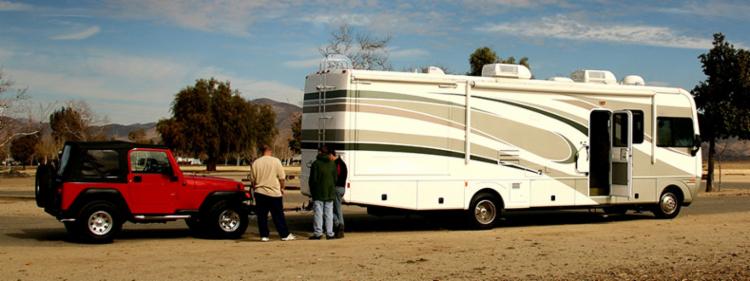How to Find Towable Cars for Your RV Vacations

Towable cars help you keep that feeling of freedom while on the road with your RV. Rather than having to unplug the electricity, plumbing and cable every time you need to head into town for supplies, you can simply unhitch your towable car and hit the road for short jaunts and sightseeing.
Many travelers become accustomed to the convenience towable cars offer and never leave home without them. Bob Livingston writes for MotorHome Magazine, "We left our dinghy home on our last trip and it felt as though we were missing a friend. You know that sinking feeling when you hit the road and discover you left something at home? It’s not quite like forgetting your dog, but leaving our Jeep at home was almost as traumatic."
Some RV owners use a car trailer for this purpose. But because of the extra weight, expense and storage involved with trailer use, most RV road warriors choose to tow a car four-down, meaning all wheels touching the ground. Dinghy style is another term for this towing method because of the resemblance to a large yacht towing a small boat, according to Edmunds. It is easier than two-wheel towing because it requires less equipment and offers quick hook-up and disassembly.
Choosing a towable car for your motor home can be more complicated than it seems, however. You can't use four-down towing on just any vehicle. If you choose the wrong car, the consequences can be permanent damage and a big headache or lots of complicated alterations that can void your warranty. That's why you should always make sure you're covered with an affordable car insurance policy.
The Wrong Cars for Dinghy Towing
Many cars with an automatic transmission, part-time 4WD or an engine-driven transmission pump will need a lot of modification before they can be towed four-down. Edmunds explains, "With automatic transmissions and pump-dependent manuals, the output shaft isn't being lubricated unless the vehicle's engine is running, and severe transmission damage can occur if they are towed with the driven wheels rolling along the highway." Kits are available to make it work, but the experts agree you're better off getting something ready to tow from the factory.
How Do You Find Towable Cars?
Several guides and magazines for RV lovers offer listings each year of the best cars for dinghy towing, but your car's owner manual is the final authority. Every car comes with explicit instructions for four-down towing. The two main features you can look for are full-time 4WD vehicles with manual transmissions, like Jeeps, and automatic transmission vehicles that don't need engine-driven pumps for lubrication.
Edmunds warns that while a vehicle model may be towable one year, it might not be towable the next year, so always check before you buy. Some of the top choices they tried from their test fleet were the 2012 Chevy Sonic and the 2012 Honda CR-V. Livingston recommends the Chevy Spark or the Fiat 500 if you want a fuel-efficient subcompact.
Many 4WD SUVs are popular for cargo space and off-roading. Livingston also notes, "If you really want to be practical, consider one of the four passenger cars that are powered by hybrid drivetrains. Ford offers two C-MAX and two Fusion models."
You can narrow down your list of choices by first deciding on some of the following factors:
- How much do you want to spend?
- How important is fuel economy?
- How many passengers do you need to carry?
- Do you need 4WD for off-roading?
Then compare your list of criteria with MotorHome magazine's annual list of towable cars. Once you locate a great deal in your area, you're ready to tow like a pro.
How To Tow a Car Four-Down
According to the Guide to Dinghy Towing, you will need the following:
- An RV with enough towing capacity for the car you plan to tow. Most contemporary RVs have more than enough power for this purpose.
- A tow bar, preferably self-aligning, for easy one-person installation.
- A supplemental braking system for the towed vehicle.
- An underskirt or rock guard to prevent road damage to towing equipment (optional).
Be careful to follow all manufacturer instructions for attaching the tow bar and braking system. In some states, the supplemental braking system is not required, but most RV owners feel safer with it than without it. You will also need to refer to your car manual to find out how to prepare the vehicle for towing. Some cars need to be in neutral gear, while the transmission is in park, according to Edmunds. You may also need to stop and run the engine on the towed car at intervals to lubricate the moving parts thoroughly. You also must make sure that the steering is unlocked, which may mean leaving the keys in the ignition, in the accessory position.
Once you've hooked up your vehicle, you're ready to go, so drive safely and take advantage of the freedom your towable car adds to your RV adventures. When you need auto coverage for that towable car, an agent can help.
